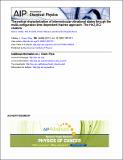Por favor, use este identificador para citar o enlazar a este item:
http://hdl.handle.net/10261/57862COMPARTIR / EXPORTAR:
 SHARE SHARE
 CORE
BASE CORE
BASE
|
|
| Visualizar otros formatos: MARC | Dublin Core | RDF | ORE | MODS | METS | DIDL | DATACITE | |

| Campo DC | Valor | Lengua/Idioma |
|---|---|---|
| dc.contributor.author | Valdés, Álvaro | - |
| dc.contributor.author | Prosmiti, Rita | - |
| dc.contributor.author | Villarreal, Pablo | - |
| dc.contributor.author | Delgado Barrio, Gerardo | - |
| dc.date.accessioned | 2012-10-11T09:03:31Z | - |
| dc.date.available | 2012-10-11T09:03:31Z | - |
| dc.date.issued | 2011 | - |
| dc.identifier | doi: 10.1063/1.3671611 | - |
| dc.identifier | issn: 0021-9606 | - |
| dc.identifier.citation | Journal of Chemical Physics 135: 244309 (2011) | - |
| dc.identifier.uri | http://hdl.handle.net/10261/57862 | - |
| dc.description.abstract | Benchmark, full-dimensional calculations on the ground and excited vibrational states for the tetra-, and penta-atomic weakly bound He 2,3ICl complexes are reported. The representation of the potential energy surfaces includes three-body HeICl potentials parameterized to coupled-cluster singles, doubles, and perturbative triples ab initio data. These terms are important in accurately describing the interactions of such highly floppy systems. The corresponding 6D/9D computations are performed with the multi-configuration time dependent Hartree method, using natural potential fits, and a mode combination scheme to optimize the computational effort in the improved relaxation calculations. For these complexes several low-lying vibrational states are computed, and their binding energies and radial/angular probability density distributions are obtained. We found various isomers which are assigned to different structural models related with combinations of the triatomic isomers, like linear, T-shaped, and antilinear ones. Comparison of these results with recent experimental data is presented, and the quantitative deviations found with respect to the experiment are discussed. © 2011 American Institute of Physics. | - |
| dc.description.sponsorship | The authors thank to Centro de Calculo (IFF), CTI (CSIC), and CESGA for allocation of computer time. This work has been supported by DGICYT, Spain, Grant No. FIS2010-18132 and the COST Action CM1002 (CODECS). | - |
| dc.language.iso | eng | - |
| dc.publisher | American Institute of Physics | - |
| dc.rights | openAccess | - |
| dc.title | Theoretical characterization of intermolecular vibrational states through the multi-configuration time dependent Hartree approach: The He 2,3ICl clusters | - |
| dc.type | artículo | - |
| dc.identifier.doi | 10.1063/1.3671611 | - |
| dc.date.updated | 2012-10-11T09:03:31Z | - |
| dc.description.version | Peer Reviewed | - |
| dc.type.coar | http://purl.org/coar/resource_type/c_6501 | es_ES |
| item.openairetype | artículo | - |
| item.grantfulltext | open | - |
| item.cerifentitytype | Publications | - |
| item.openairecristype | http://purl.org/coar/resource_type/c_18cf | - |
| item.fulltext | With Fulltext | - |
| item.languageiso639-1 | en | - |
| Aparece en las colecciones: | (CFMAC-IFF) Artículos | |
Ficheros en este ítem:
| Fichero | Descripción | Tamaño | Formato | |
|---|---|---|---|---|
| Valdes.pdf | 1,19 MB | Adobe PDF |  Visualizar/Abrir |
CORE Recommender
SCOPUSTM
Citations
9
checked on 22-abr-2024
WEB OF SCIENCETM
Citations
7
checked on 22-feb-2024
Page view(s)
327
checked on 22-abr-2024
Download(s)
306
checked on 22-abr-2024
Google ScholarTM
Check
Altmetric
Altmetric
NOTA: Los ítems de Digital.CSIC están protegidos por copyright, con todos los derechos reservados, a menos que se indique lo contrario.
